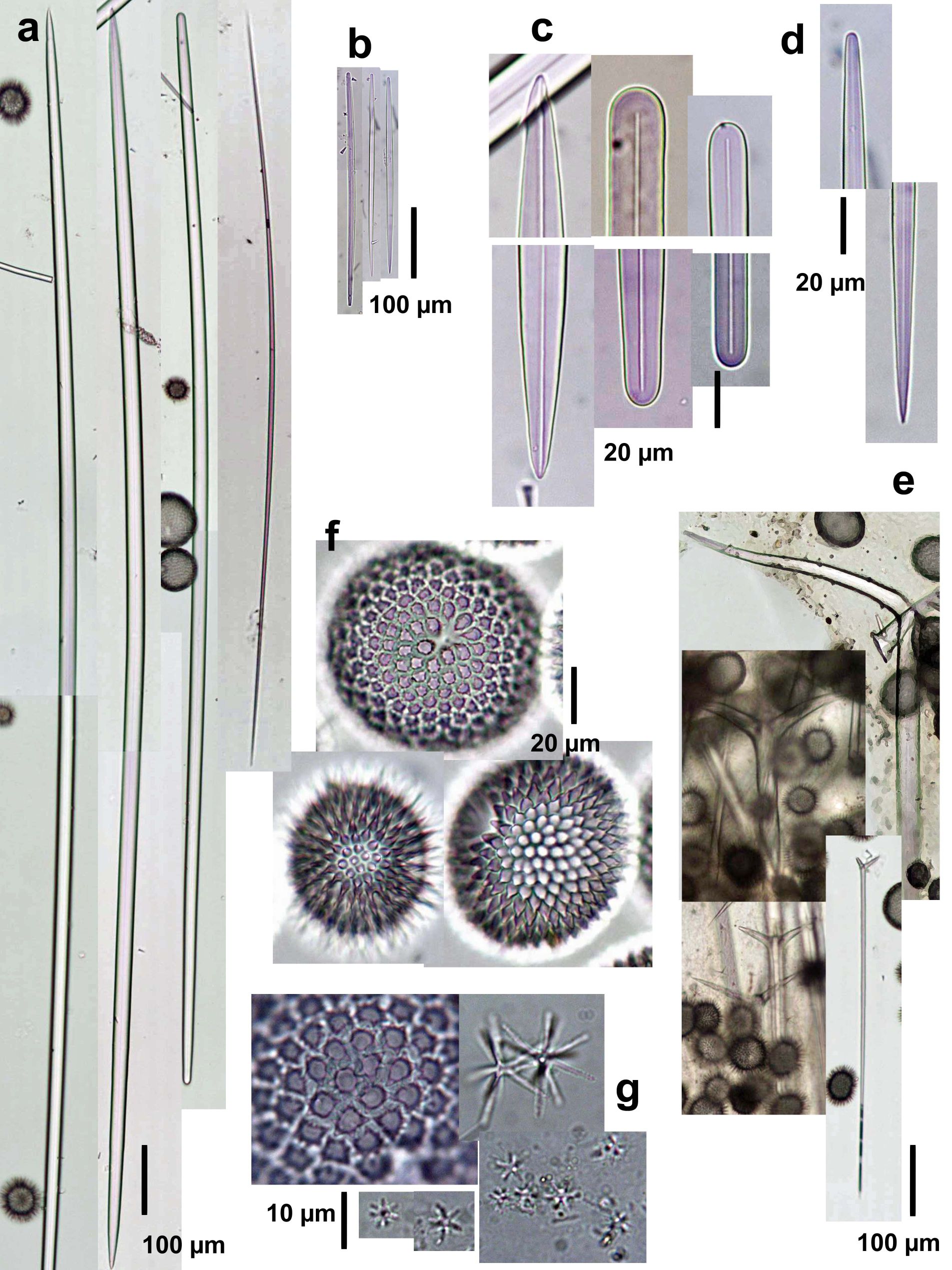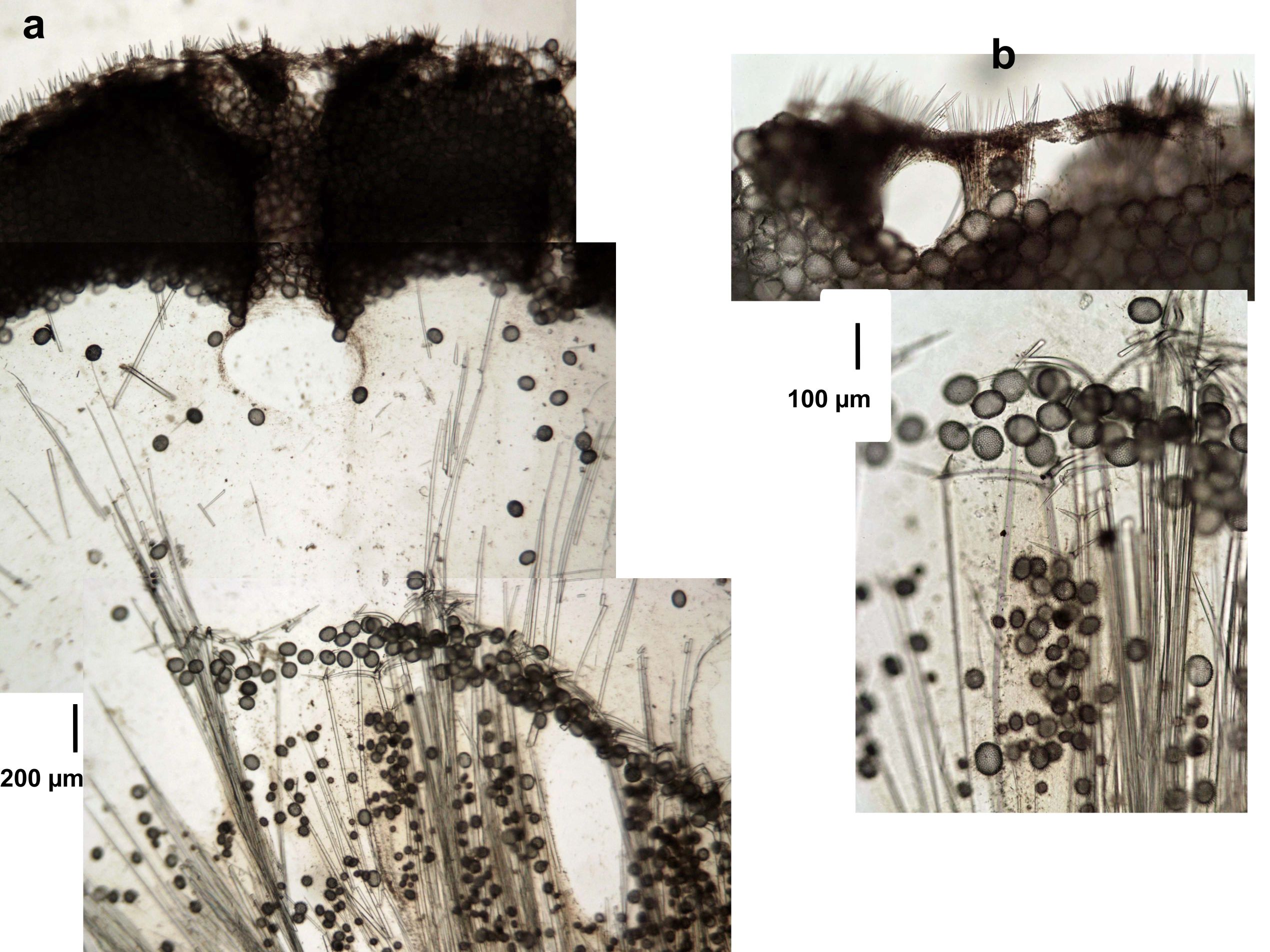the Sponge Guide - www.spongeguide.org
Observed Characteristics:
orange
cinnamon-tan
massive
hard
Bahamas
Species Description and Notes
Description: Volcano-like mounds with an upper wide circular rim surrounding a flat oscular plate, some 10-20 cm in diameter and up to about 10 cm tall. Surface is even, rather regularly perforated by shallow, probably inhalant, depressions; surface is generally clean and shiny, with parts of the oscular rim often fouled. Color is cinnamon-tan with orange tones, especially in the oscular rim; the interior is cream. Consistency is very hard and difficult to cut owing to its leathery cortex; the interior is softer. The peripheral skeleton from exterior to interior is conformed first by a cortex of densely packed sterraster microscleres, up to 1 mm in thickness, traversed horizontally and vertically by canals, the vertical ones reaching about 100-230 µm in diameter. The pinacoderm is stretched above the cortex, being heavily embedded by the smaller category of aster microscleres and traversed by bouquets of the smaller category of anystrongyloxea-oxea II megascleres. Below the sterraster cortex there follows a 1-2 mm fibrous subcortex with a few scattered erect oxea I and sterrasters. Further below, there is a 200 µm-thick subcortical layer of sterrasters aligned with the cladomes of triaene megascleres, whose rhabds are pointed downwards. These triaenes occur usually in bundles, which together with oxea I, conform ascending spicule tracts, 50-100 µm thick. In between tracts, there are abundant small oxea and anysostrongyloxea II and dispersed sterrasters and oxyasters, the latter embedded in the pinacoderm lining canals. Further inwards, the tracts are looser, with many spicules in confusion. Megasclere spicules in three types: (1) Oxea I, with several styloid and strongyloid derivations, slightly curved, usually hastate, stout, the smaller ones thin and fusiform, from 1000 to more than 2625 µm long and 11.3-32.5 µm wide. (2) Anysostrongyloxea II (several fully oxea), slightly curved, with one end narrower and blunt and the other acute, forming the superficial bouquets but also interspersed in the choanosome, 200-340 µm long and 4.7-9.5 µm wide; there appear not to be intermediate sizes in between I and II diactine megasclere categories. (3) Plagiotriaenes, with short to long, stout and usually acute clades, 50-330 µm long and 3-12 µm wide at the base; length of rhabds could not be ascertained, being 25-30 µm wide at the base; one small and thin triaene intermediate between plagio- and protriaene was seen, with clades 27.5 x 5.1 µm and the rhabd 470 x 6.8 µm. Microscleres in two basic types: (1) Sterrasters, round, relatively large, 72.5-87.5 µm in diameter, with spined rosettes up to about 5 µm in diameter; developmental stages are smaller balls surrounded by thin needles to larger ones surrounded by conical stout conical spines from which the rosettes would develop. (2) Asters in two categories (difficult to discern under light microscopy), with spined rays; large oxyasters with 7-9 slender rays, 20-22 µm in total diameter; smaller strongyl- or oxyasters, up to 6.25 µm in total diameter.
Notes: This species was found in deep reef cave roofs. It was initially lumped with G. aff. gibberosa sp.4-"melon", also pictured here, but later separated after ongoing Paco Cárdenas (Uppsala University, Sweden) molecular and morphological analyses revealed it as possibly different, but belonging the the G. gibberosa species complex. It seems to be distinct to the former by having styloid to strongyloid derivatives for the oxea I megasclere caterogy, apart from subtle differences in shape.
Tissue and Spicule Images

Spicule Images: a) Oxeas-styloids-styles-strongyles I; b) anysostrongyloxeas-oxeas II, c) enlarged tips of oxeas-styloids-styles-strongyles I; d) enlargement of an anysostrongyloxea II; e) plagiotriaenes; f) microscleres (sterrasters, developed and developing); g) enlargement of microscleres (rossettes of sterrasters on the left; spined asters in 2-3 types, oxyasters and strongyl- or oxyasters). Sample from the Bahamas.
Source Specimen: http://www.spongeguide.org/ thumbs/00063/01704.JPG

Tissue Images: a) Perpendicular section of the body (surface cortex above); b) magnification of the surface (above) and the subsurface (below). Sample from the Bahamas.
Source Specimen: http://www.spongeguide.org/ thumbs/00063/01704.JPG
Images
Geodia aff. gibberosa sp.5
Location: Bahamas, Little Inagua
Photographer: Sven Zea